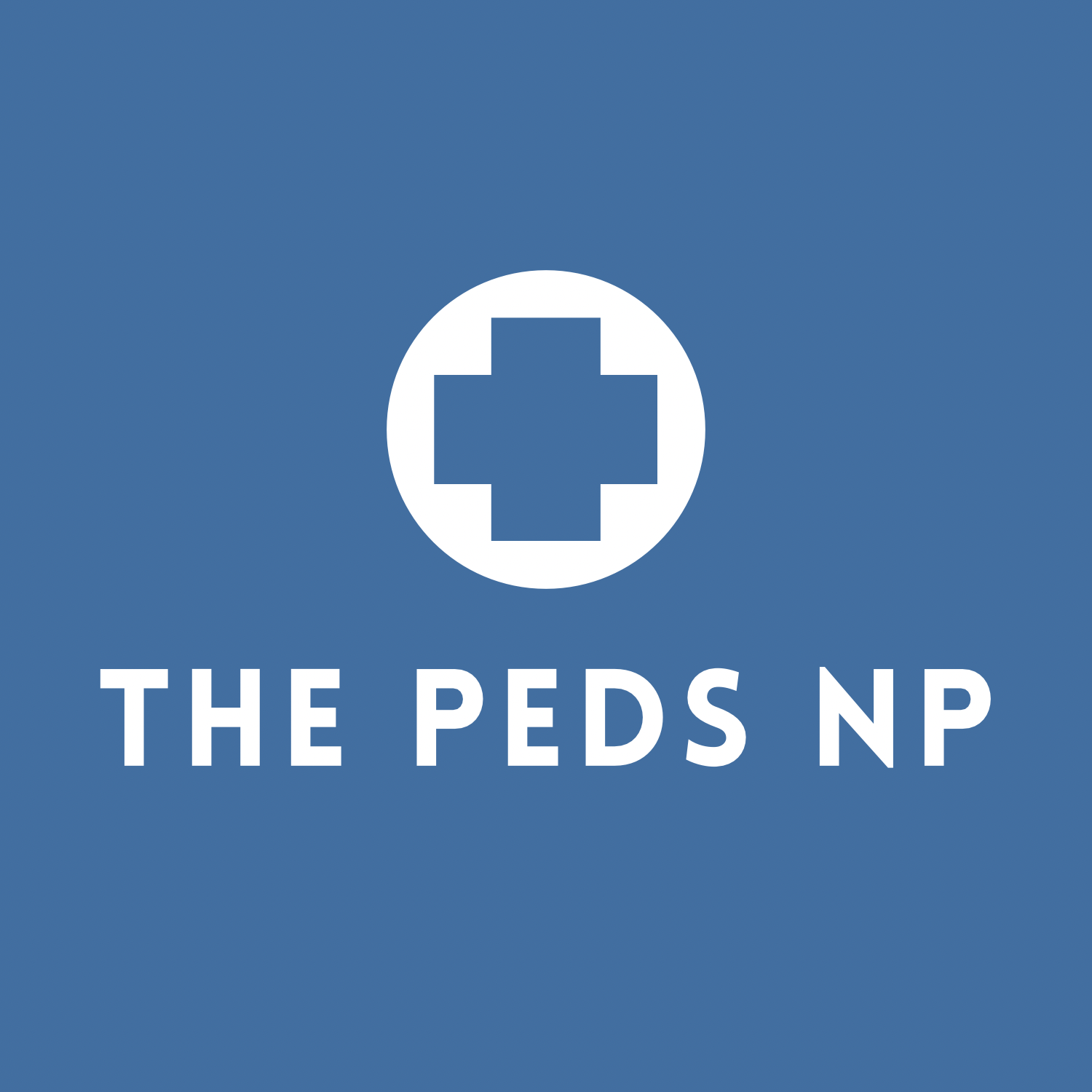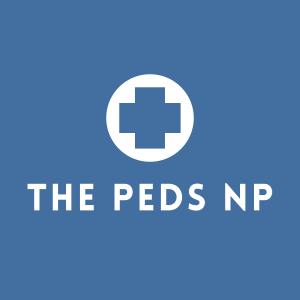

69.4K
Downloads
78
Episodes
The Peds NP provides a practical approach to the application of evidence-based practice in pediatrics using a conversational commentary to help you apply the most current literature to your practice with children. The host is Becky Carson, DNP, APRN, CPNP-PC/AC. She is a dual-certified pediatric nurse practitioner in acute and primary care and faculty member at the Duke University School of Nursing in Durham, North Carolina. Through an approachable review of the literature, you can easily apply knowledge to clinical practice to improve outcomes in pediatric care. Disclaimers & Show Notes: www.thepedsnp.com

Becky Carson, DNP, APRN, CPNP-PC/AC
Welcome to The Peds NP! I created this podcast as an asynchronous way to help my nurse practitioner students apply the concepts of our evidence-based courses to the patients that they care for at the bedside each and every day. The views are my own. Disclaimer and more at thepedsnp.com
Episodes

Monday Nov 22, 2021
2021 AAP Guidelines on Febrile Infants (S4 Ep. 38)
Monday Nov 22, 2021
Monday Nov 22, 2021
Provider variation has plagued the management of febrile neonates for decades, but the wait for standardization is over! The AAP published its long-awaited recommendations on the evaluation and management of well-appearing febrile infants 8 to 60 days old in August 2021. This episode picks apart the nuances and key features to help pediatric providers provide fast, safe, and effective care to this population. Follow along with full guideline available at https://doi.org/10.1542/peds.2021-052228
References:
Pantell, R.H., Roberts, K.B., Adams, W.G., Dreyer, B.P., Kupperman, N., O’Leary, S.T., … & Subcommittee on Febrile Infants. (2021). Evaluation and management of well-appearing febrile infants 8 to 60 days old. Pediatrics, 148(2), p. 1-38. https://doi.org/10.1542/peds.2021-052228

Tuesday Nov 16, 2021
Human Trafficking (S4 Ep. 37)
Tuesday Nov 16, 2021
Tuesday Nov 16, 2021
Human trafficking, specifically sex trafficking, is a worrisome reality that pediatric providers need to recognize and manage with speed and grace. With tools to better understand the at risk populations that may present as hidden victims of this terrible human rights violation, we can better protect our vulnerable child and youth populations.
References:
Greenbaum, J., & Bodrick, N. (2017). Global human trafficking and child victimization. Policy statement. American Academy of Pediatrics, 140, e20173138.
National Association of Pediatric Nurse Practitioners (Executive Producer). (2021). Child trafficking: Case studies and tools on identifying warning signs [Audio podcast]. TeamPeds Talks. https://anchor.fm/teampeds-talks/episodes/Child-Trafficking-Case-Studies-and-Tools-on-Identifying-Warning-Signs-S3-E3-e1833t0
Peck, J.L., Meadows-Oliver, M., Hays, S.M., & Maaks, D.G. (2020). White paper: Recognizing child trafficking as a critical emerging health threat. Journal of Pediatric Health Care, 35(3), p. 260-269. DOI:https://doi.org/10.1016/j.pedhc.2020.01.005
Philips, A. (2021). 8 terms you should know about human trafficking. Retrieved from https://restorationhousekc.org/6-human-trafficking-terms-you-should-know/
Shared Hope. (2019). Report trafficking. Retrieved from https:// sharedhope.org/join-thecause/report-trafficking/
U.S. Department of Justice. (2020). Child sex trafficking. Retrieved online from https://www.justice.gov/criminal-ceos/child-sex-trafficking

Wednesday Oct 27, 2021
Anaphylaxis with Mansi Kotwal, MD (S4 Ep. 36)
Wednesday Oct 27, 2021
Wednesday Oct 27, 2021
Recognition of anaphylaxis can be difficult for some providers, and the courage to give epinephrine for treatment can be even more so. Johns Hopkins Allergy & Immunology fellow, Dr. Mansi Kotwal, discusses the anaphylaxis presentation and diagnosis in ways you may not have considered. And she reviews adjunct drugs for management in a way that might just change your practice.
References:
Sampson, H.A., Muñoz-Furlong, A., Campbell, R.L., Adkinson, N.F., Bock, S.A., Branum, A., et al. (2006). Second symposium on the definition and management of anaphylaxis: Summary report—Second National Institute of Allergy and Infectious Disease/Food Allergy and Anaphylaxis Network symposium. Journal of Allergy and Clinical Immunology, 117, p. 391–397.

Friday Oct 08, 2021
CNS Infections (S4 Ep. 35)
Friday Oct 08, 2021
Friday Oct 08, 2021
Infections in the central nervous system can be very dangerous in children, so prompt recognition and treatment is important to avoid morbidity and mortality. A review of various etiologies of CNS infections and their workup yields a valuable discussion on a pearl of wisdom that any provider needs to understand.
References
American Academy of Pediatrics. (2018). Meningococcal infections. In Kimberlin, D.W., Brady, M.T., Jackson, M.A., & Long, S.S. Red Book (31st ed., pp. 550-561). American Academy of Pediatrics.
Centers for Disease Control and Prevention. (2021). Immunization schedules. Retrieved online from https://www.cdc.gov/vaccines/schedules/hcp/imz/child-adolescent.html
Pantell, R.H., Roberts, K.B., Adams, W.G., Dreyer, B.P., Kupperman, N., O’Leary, S.T., Okechukwu, K… & The Subcommittee on Febrile Infants. (2021). Evaluation and management of well-appearing febrile infants 8-60 days old. Pediatrics, 148(2), p. 1-40. doi: https://doi.org/10.1542/peds.2021-052228
Roy, A.G., Panicker, J., & Kumar, A. (2014). Acute CNS infections. Amrita Journal of Medicine, 10(2), p. 1-44.
Swanson, D. (2015). Meningitis. Pediatrics in Review, 36(12), p. 514-526. doi: 10.1542/pir.36-12-514

Wednesday Sep 29, 2021
Pediatric GI with John Lyles, MD (S4 Ep. 34)
Wednesday Sep 29, 2021
Wednesday Sep 29, 2021
In the first ever guest interview on The Peds NP, pediatric gastroenterologist John Lyles talks with us about pathologic hyperbilirubinemia and inflammatory bowel disease.

Monday Sep 20, 2021
Vasoactive agents in cardiogenic shock (S4 Ep. 33)
Monday Sep 20, 2021
Monday Sep 20, 2021
Cardiogenic shock occurs in children for a variety of reasons, and there are a variety of vasoactive drugs available to treat the critical condition. But first we need to understand the pathophysiology and pharmacology to best select the drug for the job, which is no easy task.
References
Bolick, B.N., Reuter-Rice, K., Madden, M.A., Severin, P.N. (2020). Pediatric Acute Care: A guide for Interprofessional Practice (2nd ed.). Jones & Barlett Learning. Burlington, MA.
CDC. (2020). Data and statistics on congenital heart defects. Retrieved online from https://www.cdc.gov/ncbddd/heartdefects/data.html
Hughes, H.K., & Kahl, L.K. (2021). Harriet Lane Handbook. Manual for Pediatric House Officers (22nd ed.). Philadelphia, PA: Mosby.
Manaker, S., Parsons, P.E., & Finlay, G. (2020). Use of vasopressors and inotropes. Retrieved online from https://www.uptodate.com/contents/use-of-vasopressors-and-inotropes?csi=40383b7b-fb7e-48d4-a09d-2d8706878bb1&source=contentShare
Pringle, C.L. (2017). PICU Essentials (1.4.0.305) [Mobile application software]. Retrieved from https://apps.apple.com/us/app/picu-essentials/id1207366521.

Wednesday Sep 15, 2021
Bronchiolitis in the Hospitalized Patient (S4 Ep. 32)
Wednesday Sep 15, 2021
Wednesday Sep 15, 2021
The 2014 AAP guidelines on the treatment of bronchiolitis are a provider's medical decision-making compass, but how can we interpret the vague or absent recommendations involving advanced care of patients requiring hospitalization? This episode covers the recent evidence published since the 2014 guidelines and helps to provide some direction on key issues for patients in need of greater respiratory support.
References:
Coletti, KD, Bagdure DN, Walker LK, Remy KE, Custer JW. High flow nasal cannula utilization in pediatric critical care: an observational study. Respir Care 2017;62(8):1023-1029.
Elliott, S.A., Gaudet, L.A., Fernandes, R.M., Vandermeer, B., Freedman, S.B., Johnson, D.W., &… Hartling, L. (2021) Comparative efficacy of bronchiolitis interventions in acute care: A network meta-analysis. Pediatrics, 147(5), e2020040816. doi: 10.1542/peds.2020-040816.
Kalburgi, S., & Halley, T. (2020). High-flow nasal cannula use outside of the ICU setting. Pediatrics, 146(5), e20194083. doi: 10.1542/peds.2019-4083.
Leyenaar, J.K., & Ralston, S.L. (2020). Widespread adoption of low-value therapy: The case of bronchiolitis and high-flow oxygen. Pediatrics, 146(5), e2020021188. doi: 10.1542/peds.2020-021188.
Mahant, S., Wahi, G., Bayliss, A., Giglia, L., Kanani, R., Pound, C.M., & … Canadian Paediatric Inpatient Research Network (PIRN). (2021). Intermittent vs continuous pulse oximetry in hospitalized infants with stabilized bronchiolitis: A randomized clinical trial. JAMA Pediatrics, 175(5), p. 466-474. doi: 10.1001/jamapediatrics.2020.6141.
Mallory, M.D., Shay, D.K., Garrett, J., & Bordley, W.C. (2003) Bronchiolitis management preferences and the influence of pulse oximetry and respiratory rate on the decision to admit. Pediatrics, 111(1), e45-51. doi: 10.1542/peds.111.1.e45.

Tuesday Sep 07, 2021
Nutrition in Critical Care (S4 Ep. 31)
Tuesday Sep 07, 2021
Tuesday Sep 07, 2021
Nutrition is arguably the most important component of care in children with critical illness, yet its importance often falls down the list of priorities. Many questions remain on how best to manage nutrition in pediatric critical care, but this episode addresses many best practices from the SCCM and ASPEN's Guidelines for the Provision and Assessment of Nutrition Support Therapy in the Pediatric Critically Ill Patient.
References
Mehta NM, Bechard LJ, Zurakowski D et al. Adequate enteral protein intake is inversely associated with 60-d mortality in critically ill children: a multicenter, prospective, cohort study. Am J Clin Nutr. 2015;102:199-206.
Mehta NM, Skillman HE, Irving SY, Coss-Bu JA, Vermilyea S, Farrington EA, McKeever L, Hall AM, Goday PS, Braunschweig C. Guidelines for the Provision and Assessment of Nutrition Support Therapy in the Pediatric Critically Ill Patient: Society of Critical Care Medicine and American Society for Parenteral and Enteral Nutrition. Pediatr Crit Care Med. 2017 Jul;18(7):675-715. doi: 10.1097/PCC.0000000000001134. PMID: 28691958.

Wednesday Sep 01, 2021
How to give a scholarly presentation (S4 Ep. 30)
Wednesday Sep 01, 2021
Wednesday Sep 01, 2021
Whether you're presenting in class, for colleagues, or on a national stage, it's important to have the tools and skills to disseminate your work in a scholarly way. This week's show focuses on helping you with presentation format, PowerPoint visuals, and presentation skills to help you stand out and confidently demonstrate your expertise.
References:
Cuddy, A. (2012). Your body language may shape who you are. Retrieved online from https://www.ted.com/talks/amy_cuddy_your_body_language_may_shape_who_you_are?language=en#t-603306
Morgan, N. (2011). Why we fear public speaking and how to overcome it. Retrieved online from https://www.forbes.com/sites/nickmorgan/2011/03/30/why-we-fear-public-speaking-and-how-to-overcome-it/?sh=5a85243f460b

Thursday Jul 22, 2021
Common Limb Deformities in Children (S3 Ep. 29)
Thursday Jul 22, 2021
Thursday Jul 22, 2021
"What's wrong with your legs?' 'Nothin' at all, thank you. My legs are just fine and dandy.'" This episode takes a line from Forrest Gump and RUNS with it. It's important for providers to know normal MSK development from an intrauterine fetus to the running child so that you can give parents reassurance for normal, expected defects while referring true deformities.
References:
Espandar, R., Mortazavi, S.M.J., & Baghdadi, T. (2010). Angular deformities of the lower limb in children. Asian Journal of Sports Medicine, 1(1), p. 46-53. doi: 10.5812/asjsm.34871
Gupta, P., Gupta, V., Patil, B., & Verma, V. (2020). Angular deformities of lower limb in children: Correction for whom, when and how? Journal of Clinical Orthopedics and Trauma, 11(2020), p. 196-201. https://doi.org/10.1016/j.jcot.2020.01.008
Scherl, S.A. (2004). Common lower extremity problems in children. Pediatrics in Review, 25(2), p. 52-62. doi: 10.1542/pir.25-2-52